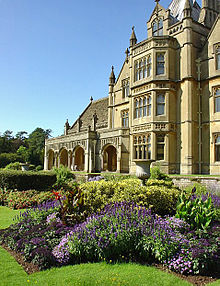Bath stone
Bath Stone is a historically significant stone in southern England. It is an oolithic limestone with granular calcium carbonate fragments and sidereal pigment content. It originated in the Middle Jura . In Germany, mineralogists also use the traditional name " Rogenstein " for comparable rocks .
Occurrence and historical use
The large limestone deposit in which the Bath Stone can be found as natural stone extends in Great Britain from Purbeck and the island of Portland in the south of Great Britain via Bath and Box and Northamptonshire , Lincolnshire , Collyweston to the North Yorkshire Moors.
The Bath Stone was already quarried in Roman times and used to build villas and baths. The Roman quarries were south of Bath .
In the 1720s, the entrepreneur Ralph Allen acquired the quarries previously operated as a small business at von Combe Down and Bathampton near Bath and ran them as a whole. The limestone became a popular building block during the building boom in Bath in the 18th century, when almost the entire city center was built or clad in the Georgian style from Bath Stone due to its warm, honey-yellow color and its good processing possibilities . Because of Bath's fame in the 18th century and the use of the stones by the noted architect and architectural writer John Wood the Elder , the stone became a downright fashion item. Allen built a railroad track to transport the stone blocks, with the help of a natural gradient the blocks could be transported from the quarries to Bath and to the loading point on the Avon and thus sold by ship throughout Great Britain.
Role of the box tunnel
Bath Stone was dismantled , among other things, during the construction of the Box Tunnel, which was driven in 1836, and served as an additional source of income for the associated railway line.
Huge quarries were built underground between Box Hill and Corsham, branching off the tunnel. From there the stones were transported to the tunnel and with a narrow-gauge railway along the railway line in the tunnel. With the possibility of transporting the stones by rail, a large market could be reached. The quarrying industry peaked between 1880 and 1909 when millions of tons of limestone were sold. The quarries in the underground tunnel system remained open until 1969. Some colleges at Oxford University were also built with Box Bath Stone.
Follow-up uses of the quarries
After 1936, a number of deposits and former quarries served as ammunition depots and later as air raid shelters. The quarry near Corsham was expanded into the central nuclear-safe reduit of the British government during the Cold War.
The Combe Down and Bathampton Down mines, mined since the 17th and 18th centuries, are now known to be important home to various protected bat species, especially horseshoe bats .
In 1908, the Bath and Portland Stone company was formed into the Bath Stone Firms in 1887 from seven stonemason companies and in 1889 the Bath Stone Firms took over the Portland stone quarries , which were exploited for the production of cement in addition to this use.
In 1999 a number of the earlier quarries began to be filled with foam concrete.
Usage today
Today there are still two active quarries extracting the Bath Stone , these are Monk's Park in Corsham, Wiltshire, with a light cream-colored natural stone called Hartham Park Ground stone , and Stoke Hill Mine in Bath, with a honey-yellow natural stone that Box ground stone . The quarries are operated by Hanson Bath and Portland Stone , a group of the German construction company Heidelberger Zement .
The Bath Stone comes on the market with the above name and is now mainly used for restoration purposes, but also for sculpting, masonry, chimneys, vases, window and door panels, bathrooms and floor and wall coverings and for fountains, tombstones and monuments.
Individual evidence
- ^ Bath Stone Mines: Online information , accessed April 27, 2011
- ↑ a b heidelbergercement.com : Bath stone (English), accessed on April 27, 2011
- ^ For sale: Britain's underground city
- ↑ Combe Down and Bathampton Down Mines (PDF; 51 kB) In: English Nature SSSI Citation Sheet . Retrieved July 13, 2006.
- ^ Heidelbergercement.com : The history of Bath and Portland stone , accessed on April 27, 2011
- ^ The Derelict Land Clearance Area (Combe Down Stone Mines, Bath) Order 2002 . In: Statutory Instruments HMSO, the Queen's Printer of Acts of Parliament. . Retrieved July 13, 2006.



